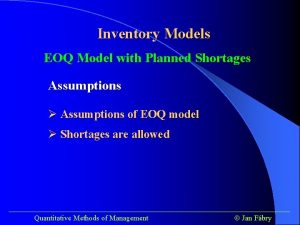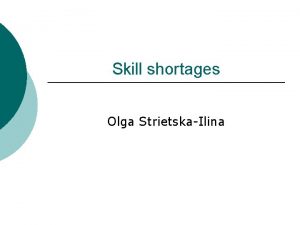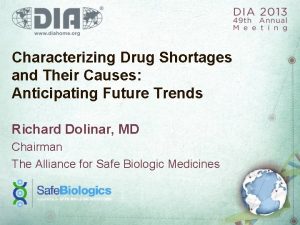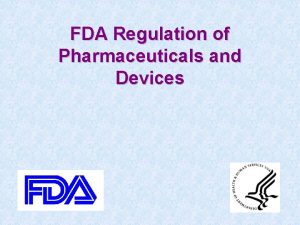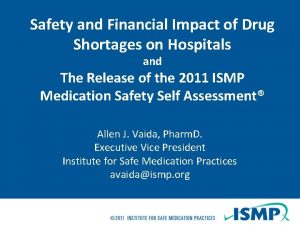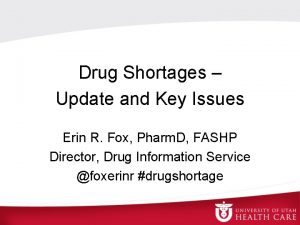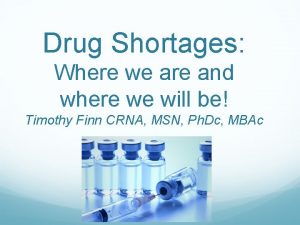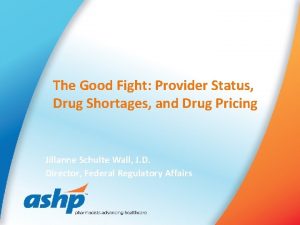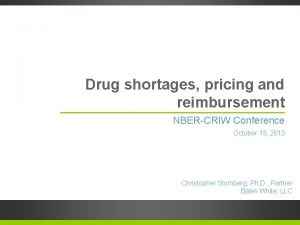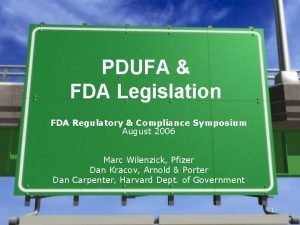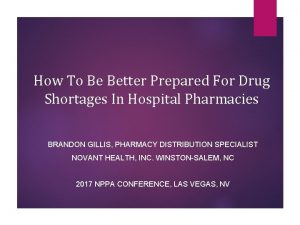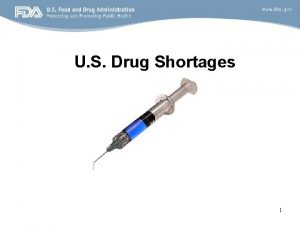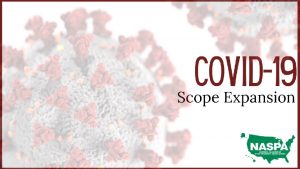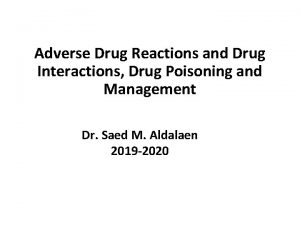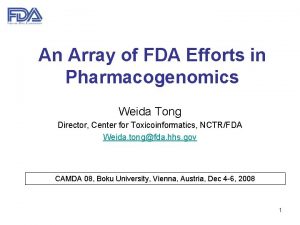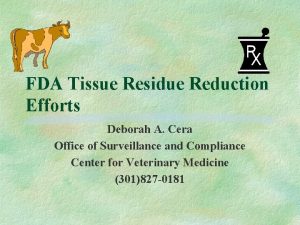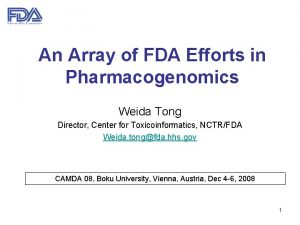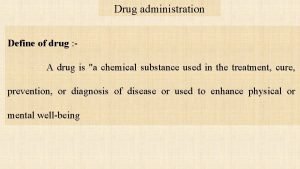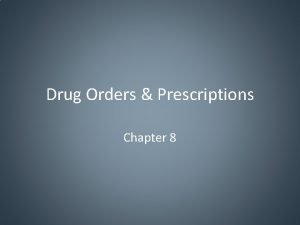DRUG SHORTAGES FDA EFFORTS CURRENT CHALLENGES AND FUTURE





























- Slides: 29

DRUG SHORTAGES: FDA EFFORTS, CURRENT CHALLENGES AND FUTURE GOALS CDR Jin Ahn, Pharm D, RAC CDR Leo Zadecky, RPh, MS, RAC FDA Center for Drug Evaluation and Research Drug Shortage Staff

Disclaimer This presentation reflects the views of the presenter and should not be construed to represent FDA’s views or policies. 2

Disclosures CDR Jin Ahn, Pharm D, RAC Financial Relationships: Employed at the Food and Drug Administration Drug Shortage Staff Nonfinancial Relationships: None 3

Disclosures CDR Leo Zadecky, RPH, MS, RAC Financial Relationships: Employed at the Food and Drug Administration Drug Shortage Staff Nonfinancial Relationships: None 4

Learning Objectives At the completion of this activity, the participant will be able to: 1. Identify what FDA can and cannot do to prevent and mitigate drug shortages 2. Describe how to report a drug shortage to the FDA 3. Summarize pharmaceutical Industry’s role in drug shortage prevention and mitigation 5

What do you know right now about Drug Shortages? True or False? Medical Necessity is determined by the applicant and or manufacturer of a drug product? FDA can direct a manufacturer to make volumes necessary to sustain a market need. FDA can direct industry where to distribute products. 6

What do you know right now about Drug Shortages? Question: How do you report a drug shortage situation to the FDA ? A. File Med. Watch form FDA 3500 B. File FDA form 483 ? C. Report a drug shortage situation through email : drugshortages@fda. hhs. gov or by calling 240 -402 -7770 D. All of the above will work to communicate a shortage. 7

Drug Shortage Mission • Our mission is to prevent, mitigate and alleviate drug shortages • Patient and practitioner access to life-saving medication is our #1 priority • Drug Shortage Staff works with professional organizations, patient groups, clinicians and other stakeholders (DEA, CMS, EMA. . etc. ) Brief History • Part of FDA’s Center for Drug Evaluation & Research (CDER) • Drug Shortage Program began in 1999 • 2011 - President Obama signed Executive Order 13588 -Reducing Prescription Drug Shortages • 2012 -Requirements to Industry For Early Notifications Under Section 506 C of the FD&C Act • Food and Drug Administration Safety and Innovation Act (FDASIA) • CDER DSP to Drug Shortage Staff (DSS) in 2012 • CDER Office of the Center Director in 2014

FDA Drug Shortage Staff (DSS) Drug Shortage Staff: The program office that is designated by FDA to oversee and facilitate the resolution of all drug shortage situations DSS serves to support FDA’s mission of ensuring that safe and effective drugs are available to patients • Facilitate temporary and long-term strategies to address shortages • Coordinate for timely and comprehensive risk/benefit decisions • Distribute information (web posting, professional organizations, e. g. ASHP) Often working across suppliers, facilities, and issues – multiple moving parts, urgency Maintain availability while minimizing risk to patients

FDA Drug Shortage Staff – Key Communications

Notification REQUIREMENTs Under Section 506 C of the FD&C Act AND FDA REGULATIONS Manufacturers are required to notify the FDA of a permanent discontinuance in the manufacture of a covered drug or an interruption of the manufacture of a covered drug that is likely to lead to a meaningful disruption in the supply of the drug in the United States • “At least 6 months in advance of the date of the permanent discontinuance or interruption in manufacturing; or, if 6 months’ advance notice is not possible no later than 5 business days after the…permanent discontinuance or interruption in manufacturing occurs” • Not limited to medically necessary products • Regardless of market share, or number of companies marketing, or wholesaler volumes

Drug Shortage Defined Drug Shortage: A period of time when the demand or projected demand for the drug within the United States exceeds the supply of the drug. In general, the DSS focuses on shortages of medically necessary products that have a significant effect on public health.

Medical Necessity In general, a medically necessary drug product is a product that is used to diagnose, treat, or prevent a serious disease or medical condition for which there is no other drug that is judged by medical staff to be an appropriate substitute or there is an inadequate supply of an acceptable alternative as determined by the DSS. *Although the FDA focuses on medically necessary drugs, all actual and potential shortages are evaluated to help determine the possible public health impact.

Manufacturers Report on Potential Impact to Supply At the time of any change in manufacturing that may lead to a reduction in supply of a product*, e. g. : • Plans for upgrade or remediation • Manufacturing issues • Raw material batch failures • Particulate issues • Sterility issues *Note, product refers to a specific strength, dosage form, and route of administration

Manufacturers Report on Potential Impact to Supply FDA asking manufacturers to notify FDA ahead, not as, or after, they are unable to fill orders or unable to meet expected demand Best Practices “We have placed the following product(s) on hold pending an investigation. Due to the investigation being in progress and the completion date being not estimated at this time, we wanted to inform Drug Shortage of this potential for a supply interruption. ”

Drug Supply Chain – 1 st Tier Supplier Manufacturer Wholesaler Inventory/Production Data: Voluntarily Supplied Supply Interruptions: Required per FDASIA Inventory/Supply Interruptions: Voluntarily Supplied Pharmacy/Hospital Patient/Health Care Provider Sales/Market Share Data: Reported to FDA via annual report and other channels Public Notifications: FDA Drug Shortages email account 16

Opportunities and Challenges to Assist with Shortages FDA will work closely with manufacturers to address problems • We can advise, assist, and expedite inspections and reviews, but the manufacturer must fix the problem What we CAN require: • Notification by manufacturers (FDASIA) • Supply disruptions • Delays • Discontinuations • Notification of certain manufacturing changes What we CANNOT require: • A company to make a drug • A company to make more of a drug • How much of a drug is distributed and which purchasers will be given priority

The Agency’s Approach to Prevention and Mitigation • • Early notification is key!! Prioritize products that are medically necessary Risk/Benefit of the drug in question Maintain availability while minimizing risk to patients Work with firms to address problems – We can advise, assist, and expedite inspections and reviews, but the manufacturer must fix the problem

The Agency’s Approach to Prevention and Mitigation • Drug shortages cannot always be prevented – Unanticipated events occur Manufacturing breakdown or natural disaster(Hurricanes & Floods) – Sometimes alternate manufacturer may not make up production shortfall – If systemic issues present, the plant may have to close to repair – The FDA and the manufacturer can work together to encourage smart distribution (allocation)

FDA Toolbox • Communicate possible shortage concerns on a market shortfall to other suppliers • Prompts firms to look at demand supply • Regulatory Discretion: • Manufacture of medically necessary products during remediation • Use of additional safety controls • Filters with injectable products to remove particulate concerns • Extra testing at plant • 3 rd party oversight of production • Special instructions for safe use

FDA Toolbox Expedited review of company proposals New manufacturing sites, increased expiry date, new raw material source, changes in specifications, etc. In rare cases, temporary exercise of regulatory flexibility and discretion regarding importation from other countries 2017 -2018: Dextrose 5% in Water, SWFI, Technetium injection, IV Saline Solution, Hydromorphone Injection, Potassium Chloride injection, Sodium Bicarbonate injection.

Impact of Early Notifications to the FDA • Ongoing dialogue/work with industry – high numbers of prevented shortages continue (115 in 2016, 145 in 2017, 160 in 2018) • Depending on the precipitating events, some drug shortages can endure for months to years. (Ex: Plant remediations and agency approvals) Total Prevented US Drug Shortages Per Year

Current Challenges: Increasing new shortages and persistent shortages • Shortages peaked in 2011 at 251, and continued to decline through 2016. Shortages rose again in 2017 and 2018 due in part to the 2017 hurricane impact as well as ongoing problems at manufacturers. • Depending on the precipitating events, some drug shortages can endure for months to years. (Ex: Plant remediations) Total New US Drug Shortages Per Year

Examples of Current Shortages Affecting Patients Injectable hospital drugs including pain medications and local anesthetics Epinephrine autoinjectors Ophthalmic solutions including glaucoma agents Valsartan oral tablets have been in short supply due to the detection of nitrosamine impurities

Role of Industry to Help Prevent and Mitigate Drug Shortages • Understand the frailties of their supply chain • Communicate early about potential shortages • Provide shortage information for posting on FDA website when a shortage is unavoidable • Provide short term and long term plans for preventing and addressing shortages while maintaining and improving quality • Work with FDA to minimize shutdowns or slowdowns that will lead to shortages

Next Steps FDA announced July 12, 2018, that a new FDA Task Force was implemented to identify more enduring solutions for shortages. A public meeting was held November 27 th, and additional stakeholder engagement has been conducted. The report was published in October 2019. The report identifies three root causes for drug shortages: 1. Lack of incentives for manufacturers to produce less profitable drugs 2. The market does not recognize and reward manufacturers for “mature quality systems” that focus on continuous improvement and early detection of supply chain issues; and 3. Logistical and regulatory challenges make it difficult for the market to recover from a disruption. The report also recommends enduring solutions to address drug shortages. These solutions include: 1. Creating a shared understanding of the impact of drug shortages on patients and the contracting practices that may contribute to shortages; 2. Developing a rating system to incentivize drug manufacturers to invest in quality management maturity for their facilities; and 3. Promoting sustainable private sector contracts (e. g. , with payers, purchasers, and group purchasing organizations) to make sure there is a reliable supply of medically important drugs.

Contacts: Current shortage information updated daily at: https: //www. accessdata. fda. gov/scrip ts/drugshortages/default. cfm To contact DSS: Email: drugshortages@fda. hhs. gov FDA Drug Shortages Homepage: https: //www. fda. gov/Drugs/Drug. Safet y/Drug. Shortages/default. htm Drug Shortage Mobile APP 27

References Explanation of FDA and ASHP shortage posting: https: //www. fda. gov/drugs/drug-shortages/frequently-askedquestions-about-drug-shortages#q 1 FDA Sixth Annual Report on Drug Shortages for Calendar Year 2018 https: //www. fda. gov/media/130561/download FDA Shortages Additional News And information https: //www. fda. gov/drugs/drug-shortagesadditional-news-and-information Federal Food, Drug, and Cosmetic Act (FD&C Act), Section 506 C (21 USC 356 c) https: //www. gpo. gov/fdsys/pkg/USCODE-2012 -title 21/pdf/USCODE-2012 -title 21 -chap 9 -subchap. V-part. Asec 356 c. pdf Federal Register Final Rule, 80 FR 38915 (July 8, 2015), Permanent Discontinuance or Interruption in Manufacturing of Certain Drug or Biological Products. https: //www. gpo. gov/fdsys/pkg/FR-2015 -07 -08/pdf/201516659. pdf. See also 21 CFR 310. 306, 314. 81, and 600. 82. CDER MAPP 4190. 1 Rev. 2, Drug Shortage Management (11/1995; Rev. 1, 9/2006; Rev. 2, 9/2014): https: //www. fda. gov/downloads/About. FDA/Centers. Offices/CDER/Manualof. Policies. Procedures/ucm 079936. pdf Executive Order 13588 (October 31, 2011), Reducing Prescription Drug Shortages: https: //obamawhitehouse. archives. gov/the-press-office/2011/10/31/executive-order-13588 -reducingprescription-drug-shortages. FDA Strategic Plan for Preventing and Mitigating Drug Shortages: https: //www. fda. gov/downloads/Drug. Safety/Drug. Shortages/UCM 372566. pdf Letters of Non-Compliance with Notification Requirement: https: //www. fda. gov/Drugs/Drug. Safety/Drug. Shortages/ucm 403902. htm

Thank You
 Inventory model with planned shortages
Inventory model with planned shortages Supply chain shortages are
Supply chain shortages are Difference between scarcity and shortage in economics
Difference between scarcity and shortage in economics By the time future perfect
By the time future perfect Future perfect simple vs future perfect continuous
Future perfect simple vs future perfect continuous Exhausted drug
Exhausted drug Challenges of novel drug delivery system
Challenges of novel drug delivery system Trend in media and information
Trend in media and information Ihrm trends and future challenges
Ihrm trends and future challenges Ihrm trends and future challenges
Ihrm trends and future challenges Line currents
Line currents Power formula three phase
Power formula three phase N=nc exp(-eg/2kt)
N=nc exp(-eg/2kt) Line current and phase current
Line current and phase current Drift current and diffusion current
Drift current and diffusion current What is diffusion current and drift current
What is diffusion current and drift current Balanced wye wye connection
Balanced wye wye connection Slideplayer
Slideplayer Diffusion current density
Diffusion current density Current and future issues in corrections
Current and future issues in corrections The constant-current area of a fet lies between
The constant-current area of a fet lies between Why must the electrode holder be correctly sized?
Why must the electrode holder be correctly sized? Hazard based safety engineering
Hazard based safety engineering Kcl mesh analysis
Kcl mesh analysis What is economics
What is economics See future continuous
See future continuous Tenses summary
Tenses summary Future plans and finished future actions
Future plans and finished future actions Future continuous and future perfect
Future continuous and future perfect Nulti kondicional
Nulti kondicional
